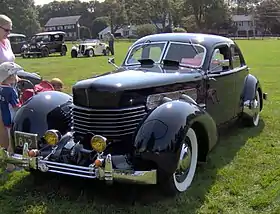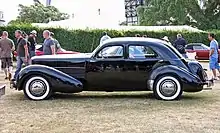Cord 810/812
The Cord 810, and later Cord 812, was a luxury automobile produced by the Cord Automobile division of the Auburn Automobile Company in 1936 and 1937. It was the first American-designed and built front wheel drive car with independent front suspension. It followed the 1934 Citroën Traction Avant and the Cord L-29, both of which also had front wheel drive. Both models were also the first to offer hidden headlights.
| Cord 810/812 | |
|---|---|
 1937 812 Phaeton | |
| Overview | |
| Manufacturer | Cord Automobile |
| Production | 1936-1937 |
| Model years | 1936-1937 |
| Layout | FF layout |
| Powertrain | |
| Engine | V8 |
History
The styling of the Cord 810 was the work of designer Gordon M. Buehrig and his team of stylists, which included young Vince Gardner and Alex Tremulis. While the first American front-wheel-drive car with independent front suspension, it had an archaic tube rear axle with semi-elliptic rear springs.[1][2] Power came from a 4,739 cc (289 cu in)[1] Lycoming V8 of the same 125 hp (93 kW) as the L-29.[3] The semi-automatic[3] four-speed transmission (three plus overdrive)[3] extended in front of the engine, like on a Traction Avant. This allowed Buehrig to dispense with the driveshaft and transmission tunnel; as a result, the new car was so low it required no running boards.[1] It had a 125 in (3,175 mm) wheelbase [4] (shared with several 812 body styles), and in 1936 came in four models: the entry-level sedan at US$1995, the Beverly sedan ($2095), Sportsman ($2145), and Phaeton ($2195).[5] The 1937 812s had the same models, priced $2445, $2545, $2585, and $2645, plus two more, on a 132 in (3,400 mm) wheelbase, the $2960 Custom Beverly and $3060 Custom Berline.[6]
Reportedly,[7] conceived as a Duesenberg and nearly devoid of chrome, the 810 had hidden door hinges[1] and rear-hinged hood,[1] rather than the side-opening type more usual at the time, both new items. It featured pontoon fenders with hidden headlamps (modified Stinson landing lights)[1] (E. L. Cord owned a majority of Stinson stock) that disappeared into the fenders via dashboard hand cranks. This car was first and one of the few ever to include this feature.
It also featured a concealed fuel filler door and variable-speed windshield wipers[1] (at a time when wipers were often operated by intake vacuum, and so tended to stop when the driver stepped on the gas pedal). Its engine-turned dashboard included complete instrumentation, a tachometer, and standard radio[1] (which did not become an industry standard offering until well into the 1950s).[8] The most famous feature was the "coffin nose", a louvered wraparound grille, from which its nickname derived,[1] a product of Buehrig's desire not to have a conventional grille.
.JPG.webp)
The car caused a sensation at its debut at the New York Auto Show in November 1935. The crowds were so dense, attendees stood on the bumpers of nearby cars to get a look. Cord had rushed to build the 100 cars needed to qualify for the show,[1] and the transmission was not ready.[1] Even so, Cord took many orders at the show, promising Christmas delivery, expecting production of 1,000 per month, but the semi-automatic transmission was more troublesome than expected,[9] and 25 December came and went with no cars built.[1] The first production cars were not ready to deliver until February, and did not reach New York City until April 1936.[10] In all, Cord managed to sell only 1,174 of the new 810 in its first model year, as the result of mechanical troubles.[3]
Supercharging was made available on the 1937 812 model, with a mechanically driven Schwitzer-Cummins unit.[11] Supercharged 812 models were distinguished from the normally aspirated 812s by the brilliant chrome-plated external exhaust pipes mounted on each side of the hood and grill. With supercharging, horsepower was raised to 170.[12]
Early reliability problems, including slipping out of gear and vapor lock, cooled initial enthusiasm. Although most new owners loved their sleek fast cars, the dealer base shrank rapidly. Unsold left-over and in-process 1936 810 models were re-numbered and sold as 1937 812 models. In 1937, after producing about 3000 of these cars, Auburn ceased production of the Cord. A single 1938 Cord prototype, with detail changes to the grille and transmission cover, was built, and it survived as of 2009.
.jpg.webp)
Ironically, the next two American cars to use a front-wheel drive layout, the 1966 Oldsmobile Toronado and 1967 Cadillac Eldorado (both built on GM's E-Body platform), also had hidden headlamps.
Revival
The 810/812 design was re-marketed almost immediately, in 1940, as ailing automakers Hupmobile and Graham-Paige tried to save money, and revive the companies, by using the same body dies. Except for their similarity to the 810, their 4-door sedans, the Hupp Skylark and the Graham Hollywood, were unremarkable. Retractable headlights gave way to plain headlight pods, and power came from a standard front-engine/rear-wheel drive design. Only about 1900 were built before production ceased in the fall of 1940.
Between 1964 and 1970, two further attempts were made to replicate the original Buehrig design for limited production. Both Tulsa, Oklahoma-based companies soon halted production amid financial difficulties. The 1966 replica Cord 8/10 was powered by a Corvair drivetrain (the "8/10" designation represented the actual scale of the car), while the 1968 through 1970 models were Ford and Chrysler powered.
The design of the Cord 810/812 remains one of the most distinctive of the 20th Century. In 1996, American Heritage magazine proclaimed the Cord 810 sedan ‘The Single Most Beautiful American Car’. The ‘Classic Cord’ Hot Wheels toy car of the 1960s, a convertible coupé, is one of the most valuable, and commands up to US$800 (2006) if still in an unopened package.
Specification

- Length: 195.5 in (4,966 mm)
- Width: 71.0 in (1,803 mm)[13]
- Height: 60.0 in (1,524 mm)
- Weight: 4,110 lb (1,860 kg).
- Ground clearance: 9 in (229 mm)[14]
- Horsepower: 125 hp (170 hp w/ supercharger)[15]
- Brakes: 12 in (305 mm) hydraulic drums[13]
- Front suspension: Independent with trailing arms, leaf springs and friction shocks.
References
- Burgess-Wise, David (1974), Northey, Tom (ed.), "Cord: The Apex of a Triangle", World of Automobiles, London: Orbis, 4, p. 436
- "Directory Index: Cord/1929_Cord/1929_Cord_Catalogue". Oldcarbrochures.com. Retrieved 2012-01-01.
- Burgess-Wise, p. 437.
- Newbury, Stephan (2006). The car design yearbook 4. Merrell. ISBN 1-85894-286-1.
- Kimes and Clark. Standard Catalog of American Cars, 1805-1942, p.364.
- Kimes and Clark, p.364.
- "Cord History 1". Automaven.com. Retrieved 2012-01-01.
- Flory, J. "Kelly", Jr. American Cars 1946-1959 (Jefferson, NC: McFarland & Coy, 2008), p.979.
- Burgess-Wise, pp. 436-437.
- "Cord front-drive car is here". The New York Times: XX7. April 12, 1936.
- Cheetham, Craig (2004). Vintage Cars - The Finest Prewar Automobiles. Rochester, United Kingdom: Grange Books. p. 67. ISBN 1840136359.
- Kimes, Beverly (1996). standard catalog of American Cars 1805-1942. Krause publications. ISBN 0-87341-428-4.
- Craig Cheetham (ed.). Ultimate American Cars. Amber Books Ltd. ISBN 0-7603-2570-7.
- "Directory Index: Cord/1936_Cord/1936_Cord_Brochure". Oldcarbrochures.com. Retrieved 2012-09-02.
- "Top Speed description of the Cord 812 supercharged". Top Speed.
Sources
- Malks, Josh B. Cord 810/812: The Timeless Classic.
- Wise, David Burgess. "Cord: The Apex of a Triangle", in Northey, Tom, ed. World of Automobiles, Vol. 4, pp. 435–7. London: Orbis, 1974.